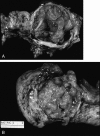Clinical and pathologic correlation of 84 mucinous cystic neoplasms of the pancreas: can one reliably differentiate benign from malignant (or premalignant) neoplasms?
- PMID: 10674612
- PMCID: PMC1420988
- DOI: 10.1097/00000658-200002000-00009
Clinical and pathologic correlation of 84 mucinous cystic neoplasms of the pancreas: can one reliably differentiate benign from malignant (or premalignant) neoplasms?
Abstract
Objective: To determine whether the long-term behavior of cystic mucinous neoplasms of the pancreas could be predicted using a novel, precisely defined classification of benign mucinous cystadenomas, noninvasive proliferative cystic mucinous neoplasms, and invasive mucinous cystadenocarcinomas. The primary interest was to obtain long-term follow-up after complete resection to determine the recurrence rates based on this objective classification.
Background: Current understanding is that all cystic mucinous neoplasms of the pancreas are potentially malignant and that mucinous cystadenomas, when completely removed, are biologically benign. Cystadenocarcinomas are thought to be less aggressively malignant than ordinary ductal adenocarcinoma, but reported recurrence rates vary widely and are unpredictable.
Methods: All patients who underwent "curative" resection for cystic mucinous neoplasms at Mayo Clinic Rochester from 1940 to 1997 were identified. All available pathology slides, gross specimens, and clinical records were reviewed, eliminating patients with inadequate documentation. Neoplasms were reclassified as mucinous cystadenomas, noninvasive proliferative mucinous cystic neoplasms, or invasive cystadenocarcinomas based on specific histologic criteria.
Results: Of 84 patients (70 women, 14 men) with cystic mucinous neoplasms of the pancreas, 54 were classified as cystadenomas, 23 as noninvasive proliferative cystic mucinous neoplasms, and only 7 as cystadenocarcinomas. Recurrent disease developed in none of the 77 patients without invasion, but 5 of the 6 patients surviving resection for cystadenocarcinomas died of recurrent cystadenocarcinoma within 5 years.
Conclusions: When the neoplasm is completely resected and subjected to adequate histopathologic examination based on these objective criteria, absence of tissue invasion predicts a curative operation and detailed follow-up may be unnecessary. In contrast, a histologic diagnosis of invasive cystadenocarcinoma portends a dismal prognosis, similar to that of typical ductal adenocarcinoma of the pancreas.
Figures




Similar articles
-
Pathologic examination accurately predicts prognosis in mucinous cystic neoplasms of the pancreas.Am J Surg Pathol. 1999 Nov;23(11):1320-7. doi: 10.1097/00000478-199911000-00002. Am J Surg Pathol. 1999. PMID: 10555000
-
[Cystic neoplasms of the pancreas: surgical therapy and chances for cure].Z Gastroenterol. 1998 Nov;36(11):939-45. Z Gastroenterol. 1998. PMID: 9880820 German.
-
An aggressive resectional approach to cystic neoplasms of the pancreas.Am J Surg. 1999 Oct;178(4):269-74. doi: 10.1016/s0002-9610(99)00186-5. Am J Surg. 1999. PMID: 10587182
-
[Cystic tumors of the pancreas].Rev Gastroenterol Mex. 1997 Jul-Sep;62(3):218-26. Rev Gastroenterol Mex. 1997. PMID: 9480530 Review. Spanish.
-
Overview of the clinical problem: facts and current issues of mucinous cystic neoplasms of the pancreas.Dig Liver Dis. 2008 Nov;40(11):837-46. doi: 10.1016/j.dld.2008.03.018. Epub 2008 May 22. Dig Liver Dis. 2008. PMID: 18499541 Review.
Cited by
-
One of the multifocal intraductal papillary mucinous neoplasms with the clinical characteristics of mucinous cystic neoplasm.BMJ Case Rep. 2013 Feb 18;2013:bcr2012008276. doi: 10.1136/bcr-2012-008276. BMJ Case Rep. 2013. PMID: 23420728 Free PMC article.
-
Mucinous cystic tumor of the pancreas with ovarian-like mesenchymal stroma in a male patient.Dig Dis Sci. 2005 Nov;50(11):2170-7. doi: 10.1007/s10620-005-3027-5. Dig Dis Sci. 2005. PMID: 16240235 No abstract available.
-
Laparoscopic distal pancreatectomy combined with preservation of the spleen for cystic neoplasms of the pancreas.J Gastrointest Surg. 2004 May-Jun;8(4):493-501. doi: 10.1016/j.gassur.2003.11.014. J Gastrointest Surg. 2004. PMID: 15120376
-
Role of endoscopic ultrasound and cyst fluid tumor markers in diagnosis of pancreatic cystic lesions.World J Gastrointest Endosc. 2022 Jun 16;14(6):402-415. doi: 10.4253/wjge.v14.i6.402. World J Gastrointest Endosc. 2022. PMID: 35978716 Free PMC article.
-
Approach to cystic lesions of the pancreas.Wien Med Wochenschr. 2014 Feb;164(3-4):44-50. doi: 10.1007/s10354-013-0244-y. Epub 2013 Nov 20. Wien Med Wochenschr. 2014. PMID: 24254128 Review.
References
-
- Katoh H, Russi RL, Braasch JW, Munson JL, Shimozawa E, Tanabe T. Cystadenoma and cystadenocarcinoma of the pancreas. Hepatogastroenterology 1989; 36:424–430. - PubMed
-
- Talamini MA, Pitt HA, Hruban RH, Boitnott JK, Coleman JA, Cameron JL. Spectrum of cystic tumors of the pancreas. Am J Surg 1992; 163:117–124. - PubMed
-
- Delcore R, Thomas JH, Forster J, Hermreck AS. Characteristics of cystic neoplasms of the pancreas and results of aggressive surgical treatment. Am J Surg 1992; 164:437–442. - PubMed
-
- Siech M, Tripp K, Schmidt-Rohlfiing B, et al. Cystic tumors of the pancreas: diagnostic accuracy, pathologic observations, and surgical consequences. Langenbecks Arch Surg 1998; 383:56–61. - PubMed
MeSH terms
LinkOut - more resources
Full Text Sources
Other Literature Sources
Medical

